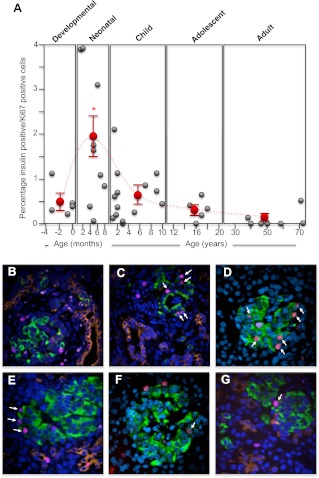Fig. 5.
The incidence of human pancreatic islet β-cell proliferation from midgestation to adult. Human pancreatic sections were analyzed by immunofluorescence and confocal microscopy as outlined in Materials and Methods for insulin (green), CK-19 for pancreatic ductal cells (orange), Ki67 for proliferating cells (purple), and nuclei (4′,6-Diamidino-2-phenylindole; blue). The number of insulin-positive cells/Ki67-positive coexpressing cells were counted and calculated as a percentage of all insulin-positive cells in each section. A, Incidence of β-cell proliferation for each human specimen during the developmental, neonatal, childhood, adolescent, and adult periods (gray circles). The mean ± sem incidence of β-cell proliferation for each period is shown as red circles. *, Significant difference (P ≤ 0.01) from the average β-cell proliferation found in adult islets. The dashed line indicates the trend in change of the average incidence of β-cell proliferation between the different life periods (note that the x-axis time scale is different for each period); B, example image of a human 24-wk-old premature pancreas (×40 magnification); C, example image of a human full-term pancreas (×40 magnification); D, example image of a human 2-month-old pancreas (×60 magnification); E, example image of a human 6-month-old pancreas (×60 magnification); F, example image of a human 7-yr-old pancreas (×60 magnification); G, example image of a human 39-yr-old pancreas (×60 magnification).

